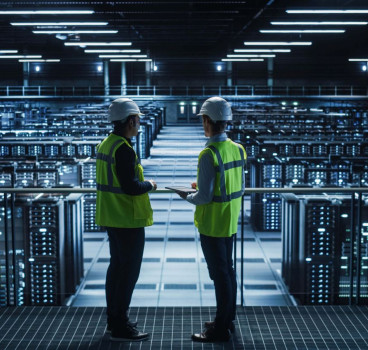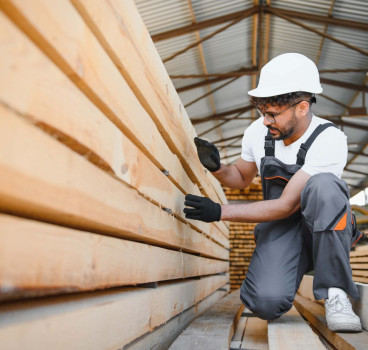Will big brother technology deliver benefits for construction?
People sensing technology - systems that track the movement, presence, or behaviour of individuals - has often been met with mixed feelings. On one hand, critics raise concerns about privacy and the "Big Brother" implications of constant monitoring. On the other hand, some argue that this technology brings invaluable benefits, particularly in industries like construction, where safety, efficiency and resource optimisation are paramount. On balance, we think people sensing is a good thing, writes John Ridgeway, but let us know what you think.
People sensing technology encompasses a range of systems that use sensors, cameras, wearables, or AI algorithms to monitor the movements and actions of individuals. Examples include infrared motion sensors, wearable GPS trackers, AI-driven cameras and smart ID badges. In construction, these tools can help track worker locations, ensure adherence to safety protocols and optimise workflows.
While its applications sound promising, the concept has sparked ethical concerns. Questions about data security, consent and potential misuse of collected information often dominate the discussion. However, a closer examination reveals that these concerns can be addressed with thoughtful implementation, leaving space for significant benefits.
Construction remains one of the most hazardous industries globally, with workers facing risks like falls, collisions and equipment accidents. People sensing technology can be a game-changer in this area. Wearable sensors, for example, can track worker location and movement, triggering alerts if someone enters a hazardous area or stops moving suddenly, indicating a potential incident. Some systems can also monitor signs of worker fatigue, reducing the likelihood of accidents caused by exhaustion.
In construction, inefficiencies can lead to delays and budget overruns. People sensing technology provides insights that can streamline operations. By tracking the movement of workers and equipment, project managers can identify bottlenecks and adjust processes to improve efficiency. Automated systems can also log workers’ arrival and departure times, reducing the need for manual check-ins and ensuring accurate payroll records. Furthermore, monitoring worker distribution across a site helps ensure that personnel are deployed where they are needed most.
Accidents on construction sites often require immediate action, which means that people sensing technology can play a vital role in emergency response. For example, in emergencies like fires or structural collapses, knowing the exact location of all personnel can speed up rescue efforts. Systems can also track whether all workers have evacuated and provide real-time data to emergency teams.
Data-driven decision making
By collecting and analysing data, people sensing technology can, in addition, offer valuable insights for construction companies. Historical data on workforce movement and behaviour can help predict and prevent issues in future projects. Tracking worker activity can also provide objective measures of productivity and identify areas for improvement.

However, a key criticism of people sensing technology is its potential to invade privacy. To address this, workers should be informed about what data is being collected, how it will be used and who will have access to it. Whenever possible, participation should also be voluntary, with alternatives provided for those who opt out.
As such systems are introduced, storing and managing sensitive data will require robust security measures. Data should be encrypted both in transit and at rest to prevent unauthorised access. Companies must also strike a balance between monitoring for safety and respecting worker autonomy. Systems should only collect data necessary for specific purposes, avoiding excessive monitoring.
Real-world applications in construction
In spite of the dangers of data breeches and possible abuse, there are real world benefits for construction. Some construction sites already use wearable devices that alert workers when they come too close to heavy machinery or unsafe zones. This not only reduces accidents but also builds trust in the technology by demonstrating its tangible benefits.
On sprawling construction sites, keeping track of personnel is a logistical challenge. People sensing tools can provide a digital map of worker locations, helping supervisors manage teams more effectively.
People sensing technology can also integrate with digital twins - virtual models of physical spaces. This combination allows construction managers to simulate workflows, test safety protocols and optimise site layouts. Some systems also incorporate environmental sensors to monitor heat, humidity and air quality. Combined with people sensing data, these tools can ensure workers are not exposed to unsafe conditions for extended periods.
As the construction industry embraces digital transformation, people sensing technology will likely become more sophisticated and widespread. Future developments may include advanced algorithms which could analyse people sensing data in real time to predict potential safety issues or inefficiencies.
People sensing systems may also work alongside robots to create collaborative environments where machines and humans can coexist safely. Furthermore, systems could adapt to the unique needs of each site, focusing on specific risks or workflows.
The debate around people sensing technology ultimately comes down to implementation. When used transparently and ethically, these tools have the potential to revolutionise the construction industry by improving safety, efficiency and decision-making. However, companies must address valid concerns about privacy and data security to build trust among workers and stakeholders.
For construction firms willing to embrace this technology responsibly, the benefits far outweigh the risks. Far from being a "Big Brother" scenario, people sensing technology can empower businesses and workers alike, creating safer, more efficient and ultimately more human-centric workplaces.
Additional Blogs

What if Building Control went fully digital?
Building control governs structural integrity, fire protection, energy efficiency, accessibility and countless other aspects of design and construction. Historically, this process has been highly...
Read moreWhere most “Smart Buildings” go wrong
Smart buildings are often presented as the ultimate in modern construction - interconnected, efficient, intuitive and driven by real-time data. They promise lower operating costs, reduced energy use,...
Read more

The future of facilities management starts at RIBA Stage 0
Facilities management has traditionally been treated as a discipline that only becomes relevant once a building is handed over. At that point, FM professionals inherit decisions made months or years...
Read more